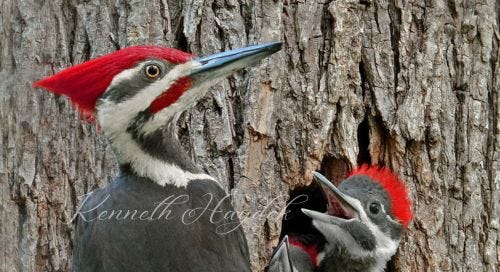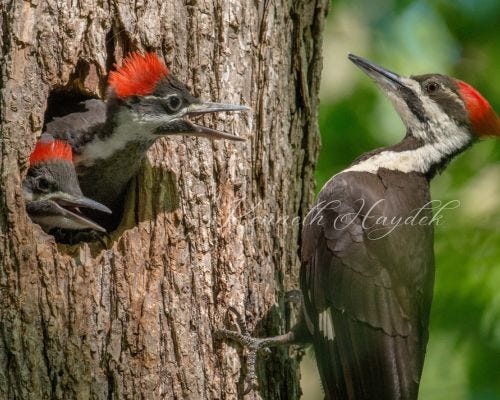August: Pileated Woodpeckers
Last month, we went out to the woods to see and hear some warbler spectacles. This month, we’re staying in the forest and keeping our eyes open for dead and decaying trees where families of pileated woodpeckers may be found.
Pileated woodpeckers are the largest woodpeckers in North America, often described as “crow-sized,” with a wingspan of about 29 inches and somewhere around 16 to 19 inches long. Unlike warblers, pileated woodpeckers do not migrate. They occupy large territories (1000 acres or more) in the United States starting around the Mississippi River all the way to the east coast, across the middle section of Canada, and in the Pacific Northwest region of the U.S.
How will you recognize a pileated woodpecker in the forest? The large size of mature pileated woodpeckers sets it apart from other woodpeckers in North America (the ivory-bill woodpecker was once a rival for the title of “largest” but is now thought to be extinct). Pileated woodpeckers have black bodies with white underwings and white on their faces and the sides of their necks. They are crowned with bright red crests. The males have distinctive red “moustaches,” whereas females have black stripes streaming out from their beaks. Their beaks are long and pointed and are very good instruments for—you guessed it—chiseling away at trees.
The drumming sound of their beaks tapping against trees may help you home in on pileated woodpeckers. Woodpeckers strike trees with their beaks as much as 12,000 times a day to get at food or to chip away their nesting cavities. Their feet have two toes facing forward and two facing backward to help them keep their grip as they balance on sides of trees. Their tongues are long and barbed; these anatomical features, combined with their sticky saliva, help them capture insects to eat. Carpenter ants are the favorite food of pileated woodpeckers as well as larvae of wood-boring beetles. They will also eat berries and nuts and sometimes have been sighted in backyards for suet and seeds.
Pileated woodpeckers make nesting cavities described as “oblong” or “rectangular” holes in dead trees or dead sections of live trees as much as 24 inches deep. The great depth of these cavities can at times even threaten the stability of more slender trees.
The presence of pileated woodpeckers in a forest is often a boon for plants and animals alike. For example, as pileated woodpeckers make their nesting cavities, woodchips are discarded and fall to the ground; as the woodchip decompose, they add to the nutrient level of the soil surrounding the tree and make prime conditions for plant growth. When pileated woodpeckers move on from their nests, the cavities are quickly occupied by any number of other woodland creatures looking for a home, such as owls, bats, squirrels, and even raccoons.
At the same time, pileated woodpeckers do have numerous adversaries. Animals that like to make a quick snack of pileated woodpeckers include snakes, foxes, eagles, owls, and hawks (like Cooper’s hawks). So, they are often on guard, especially during breeding season.
Speaking of breeding season, pileated woodpeckers typically mate for life, and the cooperation between mates really makes for an interesting family dynamic. Both sexes together build a new nest cavity each spring, with the male taking the lead and the female helping. Nest construction takes 3 – 6 weeks. They produce one brood of 3 – 5 eggs each year, having an incubation period of 15 – 18 days during which both females and males take turns incubating (with males usually taking the night shift). Both parents feed their nestlings by regurgitation. The young fledge by four weeks but are usually dependent on their parents for a few months; so, on rare occasions, entire families of pileated woodpeckers can be spotted together even into late summer or early fall.
Be sure, then, to bring your binocs and a good listening ear when you are hiking this summer—you never know which member of the family may come knocking.
Sources:
https://www.allaboutbirds.org/guide/Pileated_Woodpecker/overview
https://www.allaboutbirds.org/guide/Pileated_Woodpecker/id
https://www.allaboutbirds.org/guide/Pileated_Woodpecker/lifehistory
https://www.allaboutbirds.org/guide/Pileated_Woodpecker/maps-range
https://en.wikipedia.org/wiki/Pileated_woodpecker
https://www.audubon.org/field-guide/bird/pileated-woodpecker
https://www.birdsandblooms.com/birding/bird-species/medium-sized-land-birds/pileated-woodpecker/
https://wdfw.wa.gov/species-habitats/species/dryocopus-pileatus#desc-range
https://www.nps.gov/articles/pileated-woodpecker.htm
https://www.bird-sounds.net/pileated-woodpecker/?type1633




